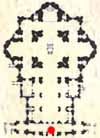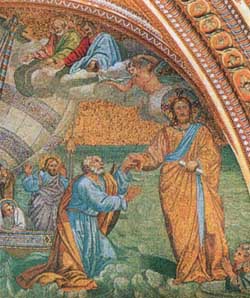 The Navicella by Giotto, 1298 |
| Grottoes
Vatican City Colonnade Saints Floorplan #2 |
| Altars
Monuments The History |
| Related
Items Portico |
|
In a lunette over the central opening into the portico is Giotto's heavily restored mosaic, the Navicella, or St. Peter walking on the Sea of Galilee. The Navicella was re-affixed in its present situation by command of Pope Paul V. 'On the right Christ is seen walking upon the waters, and almost invisible beneath him is the donor, Cardinal Stefaneschi, who gave the mosaic to Old St Peter's in 1298.' 1 |
From:
'St. Peter's - Guide to Basilica and Square'
Opposite the central entrance as one turns to look toward the square,
high up in the lunette is the "Navicella Mosaic", attributed to Giotto
(1266-1337). Only fragments remain of the original hung here in 1675,
when a copy of the artist's work was made. The mosaic shows Jesus who
is walking on the waters of the Sea of Tiberias and inviting Peter to
come to him. But Peter, letting himself be overcome by fear is beginning
to sink; Jesus saves him and says "How little faith you have! Why did
you falter?" (Mt 14:24-31).
From:
'St. Peter's Basilica - A Virtual Tour' by Our Sunday Visitor
The mosaic representing the "Navicella della Chiesa," commissioned by
Cardinal Giacomo Stefaneschi to Giotto in 1298 for the Jubilee of 1300,
is located above the main entrance of the portico. Originally rectangular,
it was located in the four-sided portico of the Old Basilica, and only
after four unfortunate transfers and various dismantling, recomposition
and restoration activities, it was placed in its current location on the
occasion of the Holy Year of 1675.
At the present time, except for a few details (the gilded edge of the ship, the sail blown by the wind, various sections of some apostles) it must -alas!- be considered as a reconstruction from the 17th century (the last radical restoration was by Marcello Provenzale) of the old masterpiece, which was also praised by Vasari.
The symbolic representation is inspired by the words of Jesus Christ, comparing the Church to a ship that is constantly battered by storms, by its numerous oppositions, but which will never sink because it can always rely on the help of its founder, depicted by the majestic figure standing on the stormy waves, with his right hand extended toward a kneeling St. Peter, while a very small figure of the cardinal who commissioned the work can be seen in the lower right corner.
1 'The Companion Guide to Rome' by Georgina Masson

